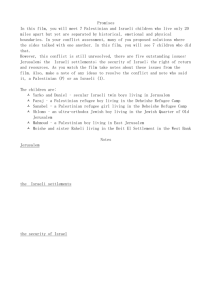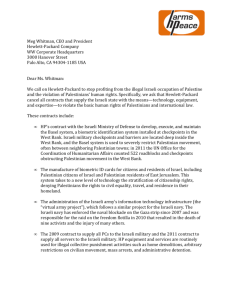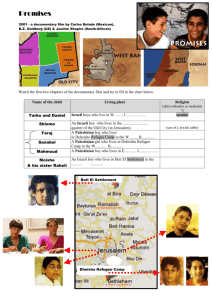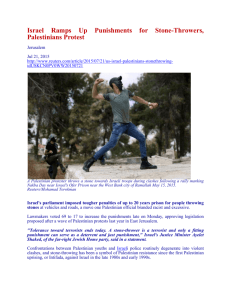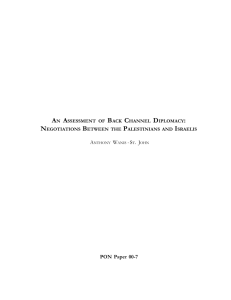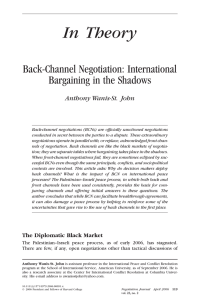pre term MBA - Wharton's SPIKE
advertisement
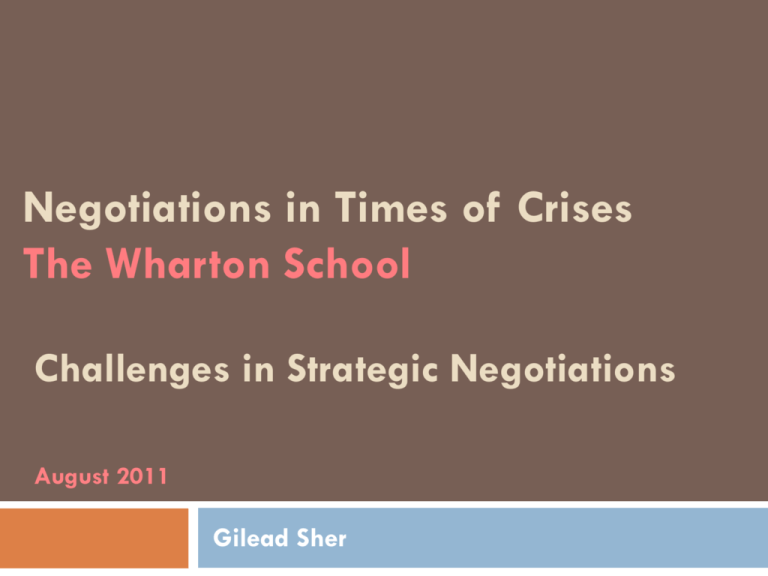
Negotiations in Times of Crises The Wharton School Challenges in Strategic Negotiations August 2011 Gilead Sher Some practical advices… The Art and Practice of Negotiations Relate to needs, rather than positions Never accept the first offer Never lose your temper: use a neutral and relaxed language In other words: keep calm and carry on Always give only against consideration Stay focused on final objective Express appreciation to the other party Understand your deal before signing Phase I Preparations, Diplomacy, Staff Work Phase II Phase III Legitimacy Advocacy Phase IV The Negotiation – Team Work EXTREMISTS OPPOSITION AFFECTED GROUPS and INDIVIDUALS SPOILERS CONFLICTING INTERESTS Phase V Reporting-Addressing spoilers-Concluding How to create VALUE on a lasting basis The right parties? The right issues? The right sequence? The right table? And then: 1. tactics (AT the table) 2. deal design (creative agreement on the surface and below it) 3. set up (extends to actions AWAY from table, to create most promising situation) Reference List Identifying the problems and barriers; Depersonalize them Strategic policy design and goal definition Setting priorities, accommodating public interests Sequential targeting; specific objectives Media, consensus building and public opinion Constituencies: legitimize “the other” Perceptions and gap analysis; standards, norms Process management in multi-issue, multi-party, multi-level set ups; Discipline Signing Timing: identifying opportunities; time issues Mandates, coalitions, spoilers – participants, opponents and other players… Reference List (Cont.) Personalities; Mindsets Momentum and leverage; walk away alternatives Improving options; Creating a larger pie Adapting to changes in conditions and circumstances, reframing; fresh thinking Creativity in general; Being purposive, neither reactive nor passive Psychological and social dimensions Rolling re-assessment The behavior of leaders and principals Getting commitments and certainty The International Arena Getting to Closing. Different Approaches to Resolving a Complex Conflict Key negotiation issues: What is the immediate and long-term purpose of the negotiations; and then What decisions need to be made now in order to achieve those aims? Who can influence those who possess power (political parties, interest groups, media, individuals); Who has the formal power and who is in fact the decision maker. Planning the Negotiations our interests our positions our counterpats’ interests positions presented by counterparts potential agreement areas Gaps and comments Roger Fisher, Beyond Machiavelli Seven Elements of Negotiation in a Conflict Situation 1. Interests 2. Options 3. Legitimacy 4. Relationship 5. Communication 6. Commitment 7. Alternatives Have the parties explicitly understood their own interests? Are sufficient options being generated? Do theprocess parties of understand other from priorities Is the inventing each separated the and constraints? Have relevant precedents and other outside process of making commitments? standards of fairness been considered? Can What is thebeability theare parties to workto the Principles foundofthat persuasive together? other side? To us? Is the way the parties communicate helping there a working relationship between theiror interfering with ability to deal constructively negotiators? Aretheir the parties paying attention to with the of conflict? Are mechanisms in the place to the kind relationship they want in future? Are potential commitments well-crafted? confirm that what is understood is in fact Does what each party know what it would like the other was intended? Does sideon? understand its Best party each to agree If the other side Alternative said yes, is to it Negotiated Agreement – itstomorrow BATNA? morning? Are the clear who would do what negative consequences of not settling being used to bring the together? Verint March 2010 parties Strategic Negotiations Media, Consensus Building and Public Opinion Preparation of Public Opinion Advocacy; lobbying; gaining legitimacy (internally and externally) In critical negotiations, concerted effort and attention must be given to continuous, comprehensive public relations Leadership must keep in touch with the groups that would be likely to experience the heaviest loss as a result of any agreement Perceptions and Symbolism Perceptions vs. Objective Facts and Evidence Symbolic Images In such negotiations one always needs to keep in mind the dignity, symbolism, tradition and heritage that the other party is concerned with. The key to close a deal would not be the “truth”, the "justice" or the objective facts, but what’s in the minds of the respective parties. If you mistakenly analyze the other side’s perception regarding its own objectives, you will constantly misread its conduct throughout the negotiation process Negotiation in times of Crisis Process Management Binding Mechanism Clear Benchmarking Perceptions Mindsets Symbolism Tradition Narratives How words can help negotiation Process Management Process management may be as vital as the substance and content of the negotiations themselves Primarily when there is a high-level third party involvement, a rigid framework that ensures progress is needed with a binding agenda from which the parties cannot be allowed to depart It is essential that the facilitator require all negotiating parties to give their responses at every stage; to dictate a clear agenda, to compose a check list of who does what, when, and follow up its implementation. Signing and Timing Signing and Timing Never leave the negotiation table before signing a document, once you have the final agreed draft ready Constantly read the battlefield map, plan ahead Simplify closing procedures Identify windows of opportunity and aim at focusing events d i n t h e W e s t B Oslo Declaration of Principles - Israel and PLO agree to mutual recognition. a n k Oslo Interim Agreement signed. Palestinian Authority to be established. , f o Israeli PM Yitzhak Rabin assassinated by right-wing Israeli fanatic Yigal Amir. Rabin is replaced by Shimon Peres l l o Right-Wing Likud leader Benjamin Netanyahu w elected Prime Minister in Israel, replacing Shimon Peres. i false rumor that a gate opened in an underground tunnel tourist "Al-Aksa tunnel riots - Arab sources spread the n attraction by the Israeli government, endangered the foundations of the Al-Aqsa mosque. This caused g several days of rioting and numerous casualties. a l Israel and Palestinians reach agreement on aIsraeli redeployment in the West-Bank city of Hebron r Wye River Plantation talks result in an agreement for Israeli redeployment and release of political prisoners and g renewed Palestinian commitment to correct its violations of the Oslo accords including excess police force, e illegal arms and incitement in public media and education. n u Israel elects Labor party leader and FormermGeneral Ehud Barak as Prime Minister in a landslide. Barak promises rapid progress toward peace. b e Israeli-Syrian peace negotiations fail when Hafez Assad rejects an Israeli offer relayed by US President Clinton in r Geneva. o f Palestinians initiated riots after Israeli opposition leader Ariel Sharon visited the Temple Mount, which is also the P location of the Haram as Sharif holy to Muslims. Start of Second Intifada See Second Intifada Timeline a l Second Intifada e Right-wing Likud leader Ariel Sharon electeds Prime Minister in Israel replacing Ehud Barak and promising "peace t and security." i The Oslo Process timeline Sept. 13, 1993 Sept 28, 1995 Nov. 4, 1995 June, 1996 Sept, 1996 Jan 18, 1997 Oct. 1998 May 17, 1999 March, 2000 Sept. 28, 2000 Feb 6, 2001 Sept. 11, 2001 Terror attacks on World Trade Center in NYC and the Pentagon carried out by fanatic Islamic Al-Qaida group headed by Osama Bin Laden initiate US war on terror. Israel and Palestinians agree to a cease fire, but it is not implemented. March-April 2002 Israel conducts operation Defensive Shield in the West Bank, following a large number of Palestinian suicide attacks on civilian targets. Saudi peace initiative adopted at Beirut summit. Jan 28, 2003 Elections in Israel give wide margin (40 seats) to right wing Likud party, returning PM Ariel Sharon for another term. March 19,2003 US begins invasion of Iraq by a strike against a building where Saddam Hussein and other leaders are meeting. Baghdad falls, April 9. Nov 11, 2004 Palestinian Authority President Yasser Arafat dies. Jan 9, 2005 Mahmoud Abbas elected President of the Palestinian National Authority. June, 200 5 Violence flares in Gaza. US Secretary of State Condoleezza Rice visits Palestinian and Israeli leaders to ensure coordination of Israeli withdrawal from Gaza. Israeli PM Ariel Sharon and Palestinian President Mahmoud Abbas meet in Jerusalem June 21. Sharon announces that Palestinians have promised to coordinate regarding Gaza withdrawal. PM Abbas postpones Palestinian legislative elections in order to change the election law, amidst growing concern that Hamas will trounce Abbas's Fatah party in the elections. Lebanese elections give a decisive majority to the opposition to Syria, led by Saad Hariri, son of slain leader Rafiq Hariri. Aug. 15, Disengagement - Israeli evacuation of Gaza settlements and four West Bank settlements The Theory of Constraints Mandates and Coalitions When you have a number of negotiating counterparts, you need to know their place in their system that has sent them, their authority within that administration and the amount of leeway they have Mobilizing resources, constituencies and stakeholders; Identifying policy allies, looking for natural coalitions and shared interests; asking yourself how motivated these potential coalition partners are/might be; Relationship mapping – locating who the real decision maker is. Who influences him; Bridging the Gaps through Creativity Every person comes to the negotiations they’ve been sent to with his/her own vision, made up of their beliefs, interests and personal experience Gain empathy, reverse roles Harvard’s Professor Robert Mnookin: Problem Solving is an orientation that seeks to create value both by minimizing transaction costs and by actively and creatively searching for trade-offs. The goal is to search for solutions that best serve your interests, while also respecting the legitimate needs and interests of the other side. Momentum and Leverage Maintaining positive momentum Confidence building measures: It is essential to create the momentum of conceding little things along the way, in order to bring the other side to closing event Seek to show visible, tangible change One needs to know that one has “earned” concessions from the other side; it is deeply rooted in human nature Adapting to Changes in Conditions & Circumstances Situations are constantly changing and you have to adapt yourself to such changes in accordance with the conditions and the mood of the people on the opposite side Think quickly, systematically and functionally Every change is important – but nothing is more significant than getting the substantive agreement concluded and, subsequently, implemented Follow your intuition Leadership Negotiations from the leaders’ perspective are merely a mechanism for communicating in order to implement strategies A leader should be concentrating on leadership, setting out principles and general policy, not on the actual mechanics of the negotiations The loneliness of the leader at the decisive moment should be addressed sensibly International and Political Negotiators All negotiators need to strive for the pie to be potentially enlarged Waiting for ever more ripeness versus the risk of failing and then overcome the heavy price of resuming negotiations after such failure Getting to Closing In the best-case scenario, the negotiators might be able to bring the parties to a point from which an agreement is achievable This is the point of balance where the compromises of one side meet the interests of the other and vice-versa Thank you, Shalom, Salam August 2011


